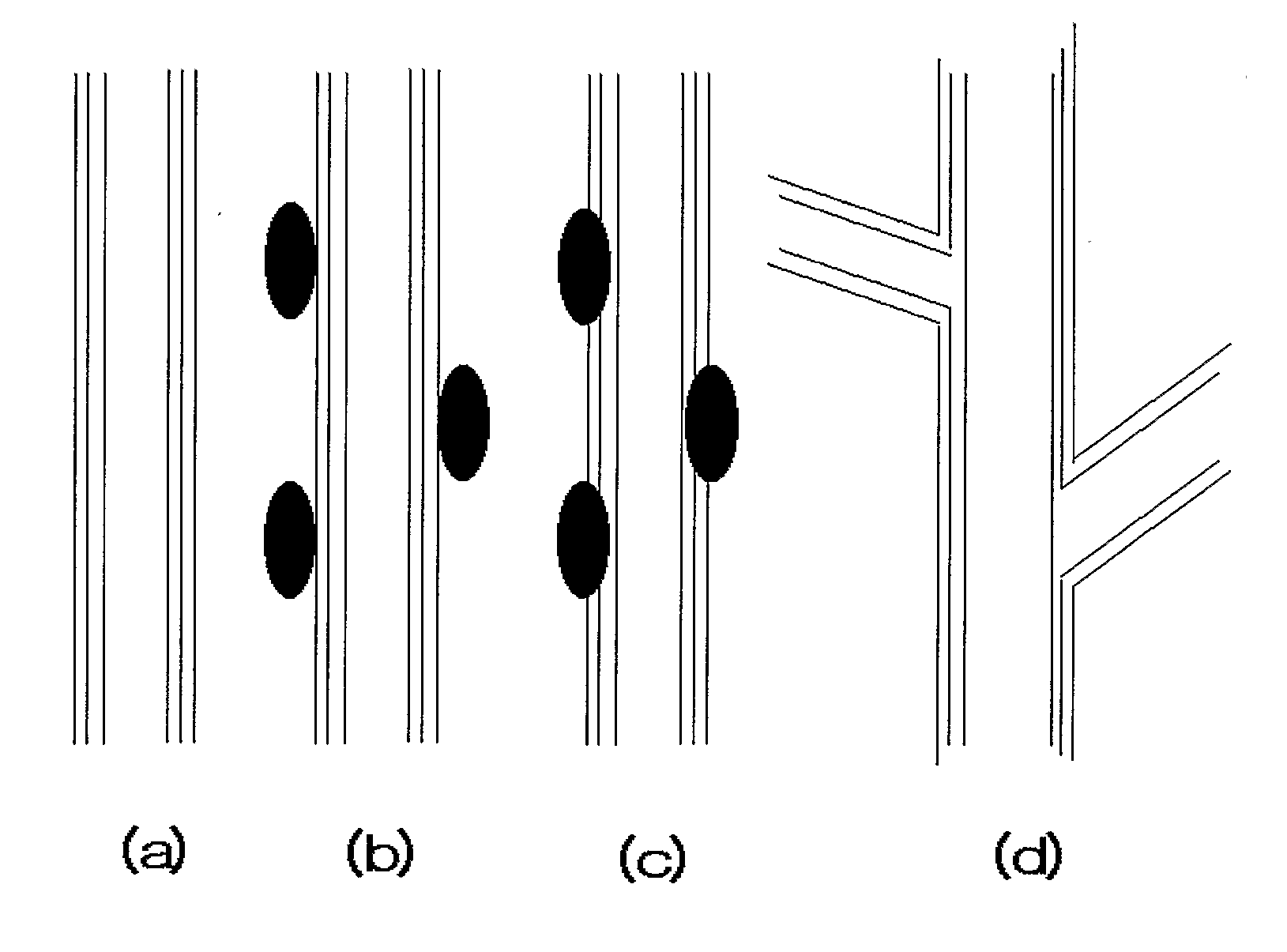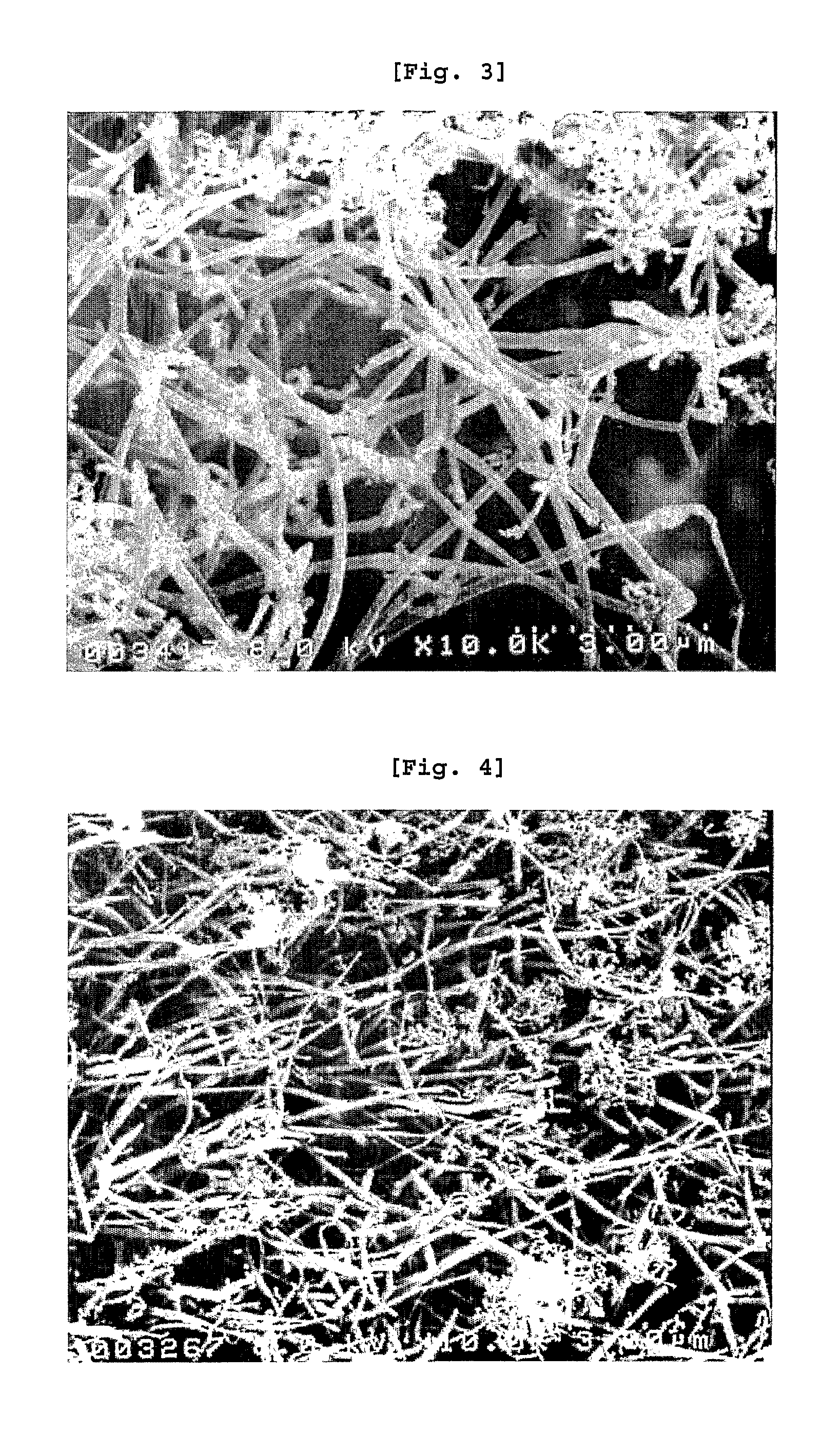Method for the Preparation of Y-Branched Carbon Nanotubes
a carbon nanotube and y-junction technology, applied in chemical/physical/physical-chemical processes, chemical apparatus and processes, energy-based chemical/physical/physical-chemical processes, etc., can solve the problem of limitation in the synthesizing of y-junction carbon nanotubes
- Summary
- Abstract
- Description
- Claims
- Application Information
AI Technical Summary
Benefits of technology
Problems solved by technology
Method used
Image
Examples
example 1
[0051] (1) Preparation of Catalyst-Loaded One Dimensional Carbon Nanotubes
[0052]1.81 g of Fe(NO3)39H2O was loaded on 10 g of multi-wall carbon nanotubes with 20 m2 / g of surface area and 60 nm in diameter [prepared as described in WO03 / 008331] by impregnation and then dried at 110° C. for 12 hours or longer.
[0053] The obtained carbon nanotubes loaded with Fe(NO3)39H2O were reduced for 3 hours with flowing hydrogen gas at 600° C. During the process of reduction, the carbon nanotubes used as a carrier were partially destructed through hydrogenation as well as reduction of iron particles and the original carbon nanotubes seemed to be bonded chemically to the newly produced carbon nanotubes. The resulted Fe-loaded carbon nanotubes comprised 2.5 wt % of Fe.
[0054] (2) Preparation of Y-Branched Carbon Nanotubes
[0055] 0.2 g of Fe-loaded one dimensional carbon nanotubes prepared in the above step 1 were put in quartz boat to be positioned at the midst of the quartz tube with 27 mm diamete...
example 2
[0058] (1) Preparation of Catalyst-Loaded One Dimensional Carbon Nanotubes
[0059] Carbon nanotubes loaded with Fe(NO3)39H2O were produced in the same manner as described in Example 1 except that the reduction was not performed.
[0060] (2) Preparation of Y-Branched Carbon Nanotubes
[0061] 0.2 g of carbon nanotubes loaded with Fe(NO3)39H2O prepared in the step (1) were put in quartz boat to be positioned at the midst of the quartz tube with 27 mm diameter in an electric furnace. The reaction temperature in the furnace was elevated to 1000° C. with flowing helium gas at a rate of 100 ml / min. Then, nitrate of ferric nitrate was thermally decomposed to oxidize the surface of carbon nanotubes loaded with ferric nitrate particles and destructed some part of the carbon nanotubes. In this way, iron particles were bonded tightly to carbon nanotubes.
[0062] When the reaction temperature reached 1000° C., hydrogen gas comprising 2 vol % of vaporized benzene was introduced into the reactor for 3...
example 3
[0064] (1) Preparation of Catalyst-Loaded One Dimensional Carbon Nanotubes
[0065] The temperature was elevated to 450° C. while helium gas was flowed on carbon nanotubes loaded with Fe(NO3)39H2O, which were produced in the same manner as described in Example 1. When the temperature reached 450° C., the gas mixture of hydrogen and H2S in the volume ratio of 95:5 was supplied for 2 hours to convert ferric nitrate to be changed to ferrous sulfide (FeS).
[0066] (2) Preparation of Y-Branched Carbon Nanotubes
[0067] 0.2 g of carbon nanotubes loaded with FeS, prepared in the step (1) were put in quartz boat to be positioned at the midst of the quartz tube with 27 mm diameter in an electric furnace. The reaction temperature in the furnace was elevated to 1000° C. with flowing helium gas at a rate of 100 ml / min.
[0068] When the reaction temperature was reached to 100° C., hydrogen gas comprising 2 vol % of vaporized benzene was introduced into the reactor for 30 minutes to produce carbon nan...
PUM
 Login to View More
Login to View More Abstract
Description
Claims
Application Information
 Login to View More
Login to View More - R&D
- Intellectual Property
- Life Sciences
- Materials
- Tech Scout
- Unparalleled Data Quality
- Higher Quality Content
- 60% Fewer Hallucinations
Browse by: Latest US Patents, China's latest patents, Technical Efficacy Thesaurus, Application Domain, Technology Topic, Popular Technical Reports.
© 2025 PatSnap. All rights reserved.Legal|Privacy policy|Modern Slavery Act Transparency Statement|Sitemap|About US| Contact US: help@patsnap.com



